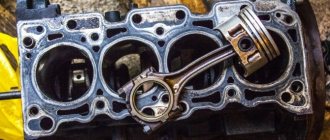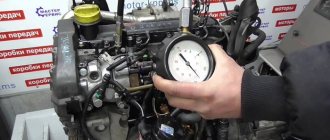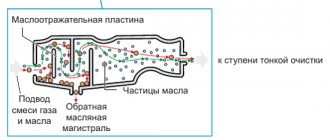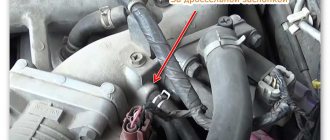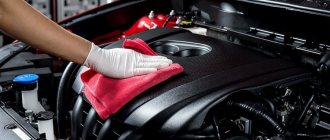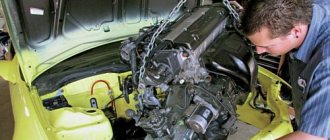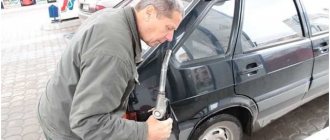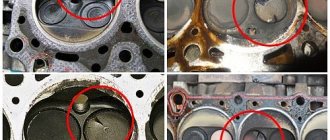Engine water hammer
If there is a puddle on the road in front of the car, many inexperienced drivers try to drive through it at high speed so as not to get stuck and get water into the car.
And this is a very serious mistake! Very often, flying into the water at speed, the car “rakes” a large amount of water into the engine and instantly stalls, shuddering with its entire body. This is the first symptom of water hammer - a dangerous breakdown in which water enters the moving mechanical components of the motor, which causes jamming and complete failure of the power unit. What to do in this situation?
Engine repair after water hammer
- Motorcycles
- Jawa Reviews/Tests
- IZH
- Minsk
- Ural/Dnepr
- Sunrise
- Scooters
- Jawa
- Jawa
- VAZ
- VAZ
- VAZ
- Motorcycles
What is water hammer and how does it occur?
Engine hydraulic shock is a sudden ingress of a large amount of water into the engine cylinders, as a result of which the pressure in the combustion chambers rapidly increases, the operating cycle is abruptly interrupted and mechanically moving parts collapse.
If the car suddenly flies into a deep puddle, water, which has a low compression threshold, is poured into the engine under high pressure, floods the combustion chamber and hits the piston, which performs rapid compression of the combustible mixture inside the internal combustion engine cylinder at a speed of up to 6000 rpm. Crashing into the water as if into a stone wall, the piston breaks, connecting rods and rods bend, cylinder head studs break, cylinder head gaskets and timing belts tear, and the crankshaft is deformed. The motor is completely destroyed and cannot be restored.
Sometimes water hammer can occur due to breakdowns in the cooling system, burnout of cylinder head gaskets, malfunctions of the carburetor or injectors: then coolant or too much fuel begins to be poured into the combustion chamber, which will certainly lead to water hammer.
What is water hammer?
Engine hydraulic shock is a phenomenon that occurs when water or a liquid with a similar substance enters the pre-piston space. Its essence is quite simple and can be explained by the ordinary laws of physics. More precisely, the water that gets in front of the piston has a noticeably higher density than the fuel mixture and, as a result, is practically not compressed. As a result, it turns out that excess pressure is created in the cavities of the engine, tens of times higher than normal, the detonation process acquires truly lethal force and the internal elements of the engine cannot withstand it.
Depending on the quality of the assembled motor and the amount of liquid that gets into it, it can experience water hammer differently. However, if it is present, the car’s engine will have to be repaired in any case - and this is in the best case. Most of the units that have suffered a water hammer are often not recoverable and require complete replacement. Such an unpleasant state of affairs occurs because the engine’s hydraulic shock can not only provoke a breakdown of the connecting rod and the piston itself, hitting the wall in the form of water, but also pierce an entire cylinder, which will already damage its fellows.
The greatest danger is caused by water hammer for diesel engines, which is due to the specific nature of diesel engines. Water hammer in them has more serious consequences, since, unlike gasoline internal combustion engines, they are more compact and the compression in this case is noticeably stronger. According to official statistics, more than 90% of diesel engines that have suffered water hammer cannot be restored. In the case of gasoline units, the situation is also not rosy, but the percentage of “fatalities” is slightly lower and amounts to 75%.
How to determine that a water hammer has occurred?
During a water hammer, the whole body of the car shakes so that you can feel it with your body while sitting in the cabin, after which the internal combustion engine immediately stalls. But hope remains: perhaps the crankshaft position sensor was simply flooded with water. Let it dry and carefully try to start the car. If the engine starts, everything is fine, you can drive on.
- A wet air filter is not a good symptom, but not critical.
- Drops of water on the spark plugs are also not a tragedy: the engine “drank” water, but its main components may remain intact.
- If the engine stalls at idle (the car flew into a puddle due to inertia), it means that a little liquid has entered the engine, but most likely there will be no critical damage.
Important! Even with these controversial signs, you should take the car for diagnostics as quickly as possible and check the condition of the engine.
The first and rather dangerous symptom of water hammer is water standing in the housing. At a minimum, it must be disassembled and the water drained, otherwise it will mix with the engine oil into an emulsion and create dangerous oil deposits.
If you flew into a puddle at high speed, and the engine was running at high speeds, and water covered the engine, after which the car vibrated strongly and stalled, the probability of a water hammer is almost 100%. This means that water entered the combustion chamber and damaged the cylinder block.
Additional signs of water hammer:
- the air filter is filled with water and deformed;
- in the cylinders there is a stepped layer of carbon deposits (almost erased from above, shiny traces from below);
- the piston in the cylinder drops below the standard level and has a strong layer of carbon deposits;
- Shiny wear stripes are visible on the liners;
- The crankshaft cannot be cranked by hand, and water leaks from the spark plug sockets.
In this situation, you cannot start the engine - other mechanical components of the car may begin to collapse. Evacuation to a service station is required.
How to determine
Signs of water hammer:
- The most typical consequence of water entering the cylinders is a dull thud that can be heard inside the car. The engine stalls. In this case, it is highly not recommended to restart the engine.
If you are not sure that you have heard something like this, but the engine stalled, do not rush to get upset. It is possible that water flooded the sensor, causing the engine to stop. In this case, first check the intake system pipes.
- There is water in the air filter housing. At the same time, the filter itself is also wet, and the air intake corrugation after the filter has traces of water.
What to do in case of water hammer?
Of course, the degree of engine destruction will depend on many factors - the quality of the water, the number of cylinders filled, the amount of water in the cylinders, the speed of the car and the engine speed. However, it is better to immediately recognize that the car has received maximum water hammer, and promptly act according to a certain algorithm:
- stop the car and put up emergency stop signs;
- unscrew the spark plug and check if there is water on it;
- disassemble the casing and check the air filter for moisture;
- try to turn the engine crankshaft with the spark plug removed - if it turns and no water flows out of the spark plug sockets, then there is no critical damage;
- try cranking the engine with the starter - if there is no knocking, then you need to blow out the cylinders, screw in the spark plugs and try to start the car.
If the crankshaft does not turn manually, or when you try to turn it with the starter, you hear extraneous sounds - there is no point in experimenting further. You need to call a tow truck and take the car to a service station to dry the engine. If after doing this and replacing the air filter the car starts and drives, you are lucky.
If the hydraulic shock turns out to be of small force, you can hope that not all the cylinders are damaged, the piston connecting rods have received minor deformation and one or two pistons have simply jammed in the liners. In this situation, you will need to replace the pistons themselves and connecting rods with pins.
What to do if a water hammer occurs and the engine stalls
If, while driving through a puddle, the car’s engine suddenly stalls with a characteristic “thump” of the car, most likely a water hammer has occurred. Drivers who have no idea what happened try to start the engine, and this is their main mistake. Under no circumstances should you try to start the engine after a water hammer.
The first step after a water hammer is to place a warning triangle behind the car. After this, open the hood and unscrew the spark plugs from the engine. Next, disassemble the air filter housing and see if it is wet. If there is moisture on it, this indicates that water has passed through it, then there is a high probability that a serious water hammer has actually occurred.
After this, you can try to start the engine. Since the spark plugs are removed, any water that gets into the cylinders can escape through the holes where the spark plugs were. To avoid damaging your car, call a tow truck and go to the nearest service station, where specialists can dry the cylinders and the engine as a whole. The air filter will also need to be replaced.
It is worth noting that the above describes the best outcome for the driver, when you only need to dry the engine and replace the filter. Unfortunately, most often water hammer leads to more serious problems - damage to the cylinder block, bent (or broken) connecting rods, and so on.
Please note: It is especially difficult to remove water from a diesel engine. This can only be done using special equipment.
How to prevent water hammer?
The best way to protect your car’s engine from water hammer is to avoid driving through puddles and to protect the car’s air intake from water. But if there is no choice, and you have to drive through a puddle, do it so that the water is no higher than half the height of the wheel.
When driving through puddles, try to move smoothly and at low speed so that water does not rake into the air intakes. Gas should be added only after the deepest point has been overcome.
If the water in the puddle is higher than necessary, it is better to stop and turn off the engine, and then try to pull the car out of the water with a cable. And it is imperative to carry out engine diagnostics immediately, at the first service station.
In conclusion, it should be noted that even water obstacles that are insignificant for a car should be overcome carefully if you want to avoid water hammer, which can destroy your engine in a matter of seconds and force you into lengthy and expensive repairs.
If you suspect that a water hammer has occurred, immediately stop trying to start the engine, check the serviceability of the crankshaft position indicator, the condition of the air filter and spark plugs, as well as the water level in the cylinder block. If you can’t get away with blowing the cylinders and drying the engine, then the engine will most likely have to be replaced.
Source
The car stalled while driving through a puddle, what should I do?
If the car engine stalls while driving through a puddle, in such a case there is a possibility of both water hammer and water getting on the electrical contacts. In such a case, drivers often try to crank the starter and start the car again. If the engine is not jammed, the crankshaft rotates, as a result of which the engine may start.
However, just such an attempt to start a stalled engine after driving through a deep puddle is a big mistake, since we only aggravate the existing breakdowns. If the connecting rod and piston were initially bent as a result of water hammer, then an attempt to start the engine may lead to rupture of the cylinder block.
The driver will need to open the air filter and inspect it for water, unscrew the spark plugs and check for moisture on them. Next, with the spark plugs unscrewed, use the starter to crank the engine; if water gets into the combustion chamber, it will be expelled through the spark plug wells. Ideally, the car should be delivered to a service center where the engine will be troubleshooted.
How to determine engine hydraulic shock?
Even a few milliliters of H2O, if the piston is at TDC (top dead center), can damage the device. A breakdown is most often diagnosed by a sudden stop of the engine and water pouring out of the pipe.
Causes of engine water hammer
Moisture penetrates through the engine compartment into the air duct (for example, when crossing a river or passing through a deep puddle at speed). Penetration through fuel is impossible - the fuel system is equipped with several stages of filtration. Injectors also prevent the appearance of H2O in the cylinders.
What does engine hydraulic shock mean for sports cars? More often than not, these “cars” and their analogues are susceptible to the malfunction in question. The fact is that the zero-resistance element has a high throughput (it is not capable of retaining small fractions of H2O, so it is recommended to additionally use a special blocking oil). Also, air ducts on “sports cars” are usually mounted low. The general conclusion is to avoid deep puddles when driving.
Symptoms of water hammer
When powertrain parts encounter H2O, the parts are destroyed or deformed (reduced in length). How to find out if there was a water hammer in the engine? The presence of trouble is signaled by:
- H2O in the intake manifold;
- curved air filter bellows;
- a thick or uneven layer of soot (after a water hammer, the engine runs, but there is more “soot” on the head than in other places - the machine needs repair);
- deformed connecting rod;
- The crankshaft liners are worn around the edges.
How does engine water hammer occur?
The damage caused depends on the ratio of the volume of liquid and the capacity of the combustion chamber. If there is not much of the first, the “knockout” goes unnoticed by the internal combustion engine (in this case, the node still suffers). In this case, troubles may overtake you at an unexpected moment - the vehicle will simply stop.
How to determine if there was an engine kick?
In the case described above, you most likely evacuate the faulty car to a car service center. There, specialists will open the “heart” of the car and find a crumpled/stuck spare part, a “dead” cylinder, a breakdown of the block, etc.
What do engine parts look like after water hammer?
An examination of the spare parts of the unit will determine what caused the malfunction. The failure will be confirmed if the following factors are detected:
- If there was little water and the car did not stall immediately, it is almost impossible to immediately determine the problem. In this situation, check the filter. The paper element will be deformed and the corrugation will be bent. With the synthetic version, traces of dried drops are looked for on the throttle valve and the walls of the air ducts.
- On the wall, above the area where the upper part of the moving part stops at the TDC position, there is a double border of carbon deposits.
- One connecting rod has failed - check the rest. When looking at the parts in the swing plane, the geometry is “wavy” (curvature is a sure sign of engine water hammer).
- A noticeable misalignment of the axes, in which an oval contact patch is visible on the connecting rod “skirt” and on the reverse side the same “mark” is located above the ring. In this case, the fire belt zone has a noticeable layer of “soot”, which is absent on the opposite side.
- An uneven edge of “soot” in the upper part of the cylinder (the characteristic shine at the bottom is evidence of water hammer on a gasoline engine).
- Shiny stripes appear on the edges of the liners - a trace of diagonal wear.
- The “dead” space above the piston is increased. The carbon deposits on the head are darker than the rest of the plaque.
Engine after water hammer
If the engine “chokes”, urgent measures are necessary. The necessary corrective actions are described below.
What to do after an engine water hammer?
If the power device suddenly stops while moving, do not start it. Indicate to other road users that a breakdown has occurred (for details, see the traffic regulations). Inspect the air filter in the engine compartment (if a wet element is found, remove it). Also check the engine block for damage and leaks (common consequences of engine water hammer).
If you don’t find anything critical, go to the car service “on your own.” Before doing this, check the functionality of the internal combustion engine. To do this, unscrew the spark plugs and “turn” the “engine” with the starter - the remaining moisture will evaporate (with water hammer in a diesel engine, such a test is impossible). If you hear any unusual sounds, don’t take risks - call a tow truck. Otherwise, install the spark plugs in place and “crawl” at low speed towards the technical center (monitor the coolant temperature and oil pressure on the road).
Engine repair after water hammer
You cannot hesitate, as rust can quickly form - you need to eliminate the consequences and resolve the issue with the water hammer of the motor. This will complicate the work and the cost of restoration will increase significantly.
The necessary repair procedures are described below:
- replacing damaged connecting rods;
- grinding the base of the head;
- installation of new timing belt/chain with tensioners and rollers;
- It may be necessary to update the piston pins (or the entire part) and the crankshaft (to be determined at the diagnostic stage).
If the engine block is damaged, restoration is impractical - the cost of the service will exceed the cost of purchasing the contract part and subsequent overhaul.
Sell engine after water hammer
We consider this enterprise dubious, since experienced car enthusiasts note that a “drowned person” will not be able to travel more than 10 thousand kilometers. The unit will be destroyed in any case. You can try your luck at special services for selling used spare parts, but it would be correct to describe everything as it is.
What to do if, when buying a used car, there is a suspicion of internal combustion engine water hammer? Be careful. For example, if you are purchasing a car from America, study the meteorological picture of the “mother” region (if there was a flood, this should alert you - perhaps the engine suffered a water hammer).
Source
Engine repair after water hammer
Having understood in detail what is happening in the engine cavities during water hammer, every reader of our resource probably understood how much the unit suffers when water gets into it. To bring an engine “hit” by moisture back to life, repairs are sometimes quite acceptable. However, in the case of a broken internal combustion engine block or deformation of the cylinders, it will be cheaper to replace the entire engine.
Motorists usually have no problems replacing the power unit, but repairing an engine with water hammer is a different matter. In fact, there are no particular difficulties in bringing the device back to life. In a typical version, you will need to resort to the following procedure:
- Let’s say the car has already been driven away from the site of its breakdown, and water hammer has been diagnosed. In this case, it is advisable to disassemble the motor and assess the degree of its destruction. However, there is an alternative assessment method. To implement it you need:
- Remove the cylinder head, unscrew the spark plugs and let the engine dry for 4 to 24 hours;
- Then, using a syringe, pour 15-20 grams of engine oil into each of the spark plug sockets;
- After this, try to rotate the crankshaft.
If the rotation is successfully completed, rejoice, the connecting rods are not even deformed and the engine only requires high-quality drying. If there are problems with shaft rotation, disassembling the motor is inevitable;
- In addition, it is extremely important to measure the engine compression. If it is significantly lower than normal, even if the connecting rods are intact, the engine should be disassembled and its other components checked. It is possible that some elements of the system failed, unable to withstand the load;
- Well, has the compression been measured and the damage from water hammer assessed? Then we act according to the circumstances: If the engine is normal, we dry the engine. To do this, we expel moisture from the engine cavities by twisting the starter for 10 seconds, and after that we leave the car to stand for another 8-12 hours;
- If the compression has dropped, there are other problems with the engine - we disassemble it and carry out the appropriate repairs.
After the necessary actions have been completed, we return the car to its original form and operate it.
Note! The algorithm described above for repairing an engine after a water hammer is relevant exclusively for gasoline units. A similar procedure for diesel is carried out at specialized service stations, which is due to its specificity.
Engine water hammer: what is it, what are the signs, consequences
Experienced motorists are well aware of the negative consequences associated with driving on a wet surface after heavy rain. Potholes and pits in which water collects are especially dangerous. Such defects in the coating should be avoided whenever possible, not only because of the possibility of mechanical damage to the car body, but also because of the high probability of engine hydraulic shock.
How does engine hydraulic shock occur?
Despite the serious consequences of water hammer, certain conditions must be created for its occurrence. Water hammer is a fairly rare phenomenon and, as a rule, happens by accident, but every car owner should understand what water hammer is in a car and how it happens.
Most often, water enters the combustion chamber through the air filter. If water gets into at least one of the cylinders of a working internal combustion engine unit, it will inevitably lead to water hammer, as a result of which the engine mechanisms that participate in the operation of the cylinders break down. In this case, there may be several types of breakdowns, both with minimal damage and more serious ones that require replacing one or several elements of the system at once.
There are two reasons why this could happen:
- In the first case, the car tries to overcome a water obstacle with a water level so high that it exceeds the level of the air intake under the hood. This level of water is quite enough to enter the air filter.
- In the second case, the car drives at a fairly high speed through a depression or deep puddle. Under such conditions, water is quickly forced into the accessible air filter housing and ends up in one or more combustion chambers.
It is worth noting that in some cases, water hammer can occur not only due to liquid entering the engine cylinders, but also as a result of a malfunction. Such malfunctions include cracks in the cylinder head or cylinder head, as well as destruction of the cylinder head gasket, through which engine cooling system fluid enters the working cylinders. In this case, water hammer most often occurs when the engine is started after a long period of inactivity, since during this period liquid has time to accumulate in the space above the piston.
This problem is diagnosed at the initial stage by monitoring the coolant level and analyzing the color of the exhaust gases. If fluid is added to the expansion tank for no other reason or the engine smokes thick white smoke, then there is a high probability of cracks or problems with the gasket.
Important! In addition to water, water hammer can also be caused by motor oil, which gets into the cylinder after a turbine breakdown.
Is it possible to restore a motor after a water hammer?
If there is a suspicion of engine water hammer, you should not attempt to start it. The car must be delivered to a garage or car service station as soon as possible.
What to do in case of engine water hammer:
Dry the engine.
Before this, you need to unscrew the spark plugs, remove the air filter and the distributor cover.
Just add oil.
A small amount of engine oil must be added to each engine cylinder through the spark plug holes. This will make it easier for the pistons to move.
We crank the engine.
Using a special ratchet wrench, you should try to crank the engine. If you manage to make one turn, then all is not lost. The connecting rods are intact and in good condition.
Compression check.
If, when measuring compression, the value was eight, you will have to dismantle the motor.
Blowing engine cylinders.
To remove water from the cylinders, you need to purge them. After this, you can reinstall the spark plugs.
Start the engine.
You need to start the engine carefully without pressing the gas pedal.
Check the running motor for extraneous noise.
The engine should not make any extraneous sounds when running. If you hear a knock, you must immediately muffle it.
What are the signs of a water hammer?
Signs of engine water hammer are indicated by a characteristic sound that occurs when passing water obstacles or after them. In such cases, the car often stalls, but sometimes there are cases when the car does not stall during a water hammer and moves quite normally for quite a long time (even up to 10 thousand km). But you shouldn’t get your hopes up in such a situation, since all this time the power unit is wearing out at an accelerated pace, which will lead to dire consequences.
What are the consequences of water hammer
The consequences of the piston hitting the gasket in the cylinder are different, so if the car was stationary and the engine was running exclusively at idle, it may simply stall. If the car was moving during the water hammer, the consequences will be more serious, since the pressure on the piston from the crankshaft will continue, creating greater forces. In this case, deformation and destruction of the liners, connecting rods, rings and crankshaft may occur.
When the piston reverses, small fragments of parts falling into the existing gap between the cylinder wall and the piston can pierce the wall or jam the piston, after which the engine cannot be restored. This is the most severe consequence of engine hydraulic shock, which is most dangerous for diesel units, since their combustion chamber volume is much smaller and the compression ratio is much higher.
When the car is traveling at low speed and the inertial forces on the crankshaft parts are not so great, the hydraulic shock impulse will not be sharp, which will help preserve the components from destruction.
In addition, the consequences of engine water hammer affect other engine parts. There are cases where strong pressure affected the deformation of the cylinder head. A sudden stop of the crankshaft during operation of the power unit leads to high mechanical stress, which acts on the drive belts and chains, as well as on their tension regulators. For this reason, they may stretch or tear, requiring replacement.
In such cases, the crankshaft is the last to suffer. It may become deformed or break due to the destruction of the piston or connecting rod gear. Destruction of the connecting rod head after a water hammer, as a rule, does not show signs of tarnish or overheating. Her appearance remains normal.
Engine damage
The degree of damage depends on the volume of water entering one or more combustion chambers and the force acting on the piston at the moment of water hammer. Diesel units are most susceptible to destruction due to water hammer. Structurally, they have high compression.
When the power plant operates at idle speed, the degree of damage to parts will be minimal. If water gets into the engine while the car is moving, this can lead to:
- bending or fracture of connecting rods;
- changing the shape of the piston;
- block head deformation;
- crankshaft bending;
- breakdown of the side wall of the cylinder block.
Consequences of water hammer
The list of damages does not end here. Parts of the crank and gas distribution mechanisms are most susceptible to destruction due to water hammer. If the damage is severe, repairing the installation may not be practical.
